
Photo: Précision Photo
Rights and Reconciliation Agreement
Forillon National Park
On April 3, 2024, the Nation Micmac de Gespeg and the Government of Canada announced the signing of the Rights and Reconciliation Agreement with respect to Forillon National Park.
The Agreement provides for the establishment of a shared governance framework between the Nation Micmac de Gespeg and Parks Canada for the implementation of joint initiatives and activities in Forillon National Park, related to
- Conservation of ecological integrity,
- the practice of traditional and harvesting activities,
- the preservation and enhancement of Indigenous cultural heritage and the creation of jobs
- and economic opportunities for the Nation Micmac de Gespeg and its members.
The Nation Micmac de Gespeg and Parks Canada have signed this Agreement out of a desire to reaffirm, solidify and maintain a relationship based on respect, cooperation and mutual support.
Press release announcing the signing of the Agreement
Consult the frequently asked questions on this subject.
Frequently asked questions
-
What are the objectives of this Agreement?
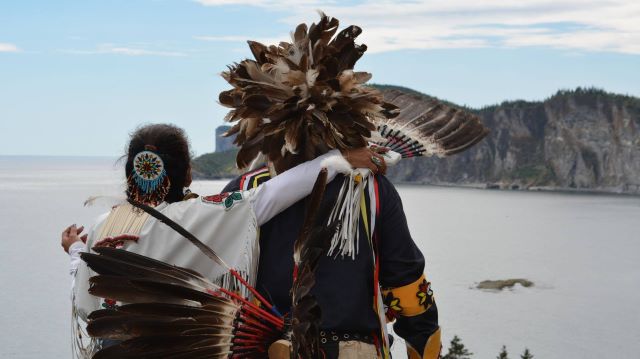
Traditional Mi'gmaq dancers at Forillon National Park during the Mawiomi.
Photo : M. Fournier/Parks CanadaThe Agreement aims to re-establish and maintain the ties between the Nation Micmac de Gespeg and its members and Forillon National Park, recognizing that Mi'gmaq culture and identity are intimately tied to their ancestral territory, Gespe'gewa'gi. The Agreement provides for the establishment of a shared governance framework between the Nation Micmac de Gespeg and Parks Canada for joint initiatives and activities in Forillon National Park, related to:
- the conservation of ecological integrity,
- the practice of traditional activities and harvesting,
- the preservation and presentation of Indigenous cultural heritage,
- and the creation of jobs and economic opportunities for the Nation Micmac de Gespeg and its members.
-
What is the term of the Agreement?
The term of the Agreement is 25 years.
-
What does the shared governance framework involve?
The Agreement provides for the creation of a shared governance committee with six members: three representatives from the Nation Micmac de Gespeg and three representatives from Parks Canada. A representative of the Nation Micmac de Gespeg will act as chair.
The committee's mandate will be to facilitate the joint development, planning, management and implementation of the objectives set out in the Agreement.
It may also act as an "advisory committee" at the request of the Nation Micmac de Gespeg (the council) and/or Parks Canada.
Once established, the committee will develop a stewardship plan that identifies priority joint initiatives and activities, timelines and the measures to be implemented to achieve the objectives.
This stewardship plan will evolve over time, according to the needs and priorities of the Nation Micmac de Gespeg and Parks Canada.
-
In concrete terms, what kinds of activities could members of the Nation Micmac de Gespeg practise in Forillon Park?
The Agreement provides for the establishment of a governance framework to develop joint initiatives and activities in a spirit of collaboration, transparency, and innovation with the Nation Micmac de Gespeg.
Before anything can be confirmed, these initiatives and activities will have to be discussed by the shared governance committee.
That said, the Agreement specifies the Gespeg nation's interests in:
- the conservation of ecological integrity,
- the practice of traditional activities and harvesting,
- the preservation and presentation of Indigenous cultural heritage,
- and the creation of jobs and economic opportunities for the Nation Micmac de Gespeg and its members.
The practice of traditional activities and harvesting will respect the guidelines developed jointly and in good faith by the Nation Micmac de Gespeg and Parks Canada.
These guidelines will take conservation, ecological integrity, and visitor safety requirements into consideration
Once the shared governance committee has established its priorities, they will be communicated to the public.
-
How do you plan to oversee traditional and harvesting activities?
The practice of traditional activities and harvesting will respect the guidelines developed jointly and in good faith by the Nation Micmac de Gespeg and Parks Canada.
As stipulated in the Agreement, the guidelines will define the terms and conditions applicable to traditional and harvesting activities and must take requirements related to the conservation of ecological integrity and visitor safety into consideration.
Harvesting is just one of many activities. The main objective of the Agreement remains the establishment of a shared governance framework between the Nation Micmac de Gespeg and Parks Canada for joint initiatives and activities that will be developed in relation to:
- the conservation of ecological integrity,
- the practice of traditional activities and harvesting,
- the preservation and presentation of Indigenous cultural heritage,
- and the creation of jobs and economic opportunities for the Nation Micmac de Gespeg and its members.
-
Are other nearby First Nations aware that this Agreement has been signed?
Yes, the communities of Gesgapegiag and Listuguj were informed and consulted at the end of the Agreement negotiation process.
-
Are any other reconciliation and rights recognition agreements being negotiated?
This agreement is the third reconciliation and rights recognition agreements to be signed with an indigenous community in the province of Québec and the Atlantic region.
Since 2017, Parks Canada and Crown Indigenous Relations and Northern Affairs Canada have been negotiating reconciliation and rights recognition agreements as part of the historic Peace and Friendship Treaties with the Wolastoqey, Mi'gmaq and Peskotomuhkati communities in the Atlantic provinces and Quebec.
Parks Canada continues to work with other negotiation tables in the Atlantic region to enter into rights recognition and implementation agreements pursuant to historic treaties. Due to the confidential nature of the ongoing negotiations, no information will be released at this time.
-
What about the place and interests of the Association of Persons Expropriated from Forillon and their Descendants?
The people expropriated during the creation of Forillon National Park and Indigenous peoples are two groups that remain important to Parks Canada. They both have a different relationship with the government, and their own attachment to the park territory, and it is on these foundations that the relationship must be built and developed.
The Government of Canada is committed to reconciliation with Indigenous peoples and to building a renewed relationship with them based on recognition of rights, respect, cooperation and partnership. The signing of this Agreement with the Nation Micmac de Gespeg is a testament to this.
In recent years, a reconciliation process has also been initiated with the expropriated people. This has made it possible to forge links and take concrete action, such as issuing passes, and the recent investment in the Grande-Grave sector to restore the houses that belonged to expropriated families. Parks Canada continues to be committed to commemorating and collaborating with expropriated people and their descendants, and efforts will continue to that end.
The shared governance committee aims to strengthen the Gespeg nation’s voice in decision-making. The creation of this committee is compatible with Parks Canada’s desire to continue working with the Association of Persons Expropriated from Forillon and their Descendants. Parks Canada will continue to consult with Indigenous people and the Association of Persons Expropriated from Forillon and their Descendants in order to benefit and serve both groups.
Our relationships with our partners and collaborators are a great asset and allow us to offer visitors new ways of discovering the history and nature of Forillon National Park.
-
Are there other national parks in Canada where Indigenous harvesting is permitted?
While these activities have been banned in some protected heritage areas, in many other Parks Canada administered sites across the country, Indigenous people continue to practise harvesting— including hunting, trapping, gathering and fishing—as they have for millennia, in a completely safe way. Harvesting activities are carried out in a way that ensures public safety and that aligns with conservation objectives.
The Government of Canada is committed to a process of reconciliation with Indigenous peoples and to renewing relationships with them based on the recognition of rights, respect, cooperation and partnership.
The action plan associated with the United Nations Declaration on the Rights of Indigenous Peoples Act identifies the removal of barriers to Indigenous harvesting activities in heritage places administered by Parks Canada as a priority.
Parks Canada is currently working with Indigenous partners to facilitate the exercise of harvesting rights where barriers exist, and to develop and implement other site-specific approaches that respect Indigenous knowledge systems, governance, laws, languages, cultures and relationships.
Although other examples exist across the country, Forillon National Park is the first national park in Quebec to adopt an agreement that includes provisions for the practice of traditional and harvesting activities. Indigenous peoples already safely practise harvesting in many protected heritage sites across the country, including about half of our national parks.
-
View the photo album of the announcement of the signing of the Agreement.
The press conference began with a smudge ceremony and a song of honour.
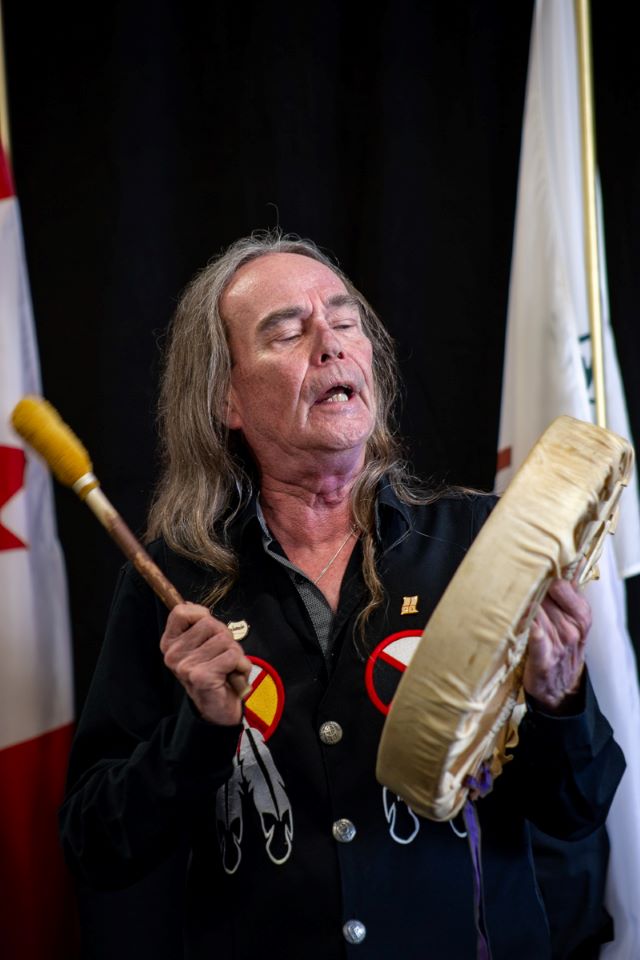
Song of honour performed by Mr Tim Adams, Gespeg elder
Photo: Précision Photo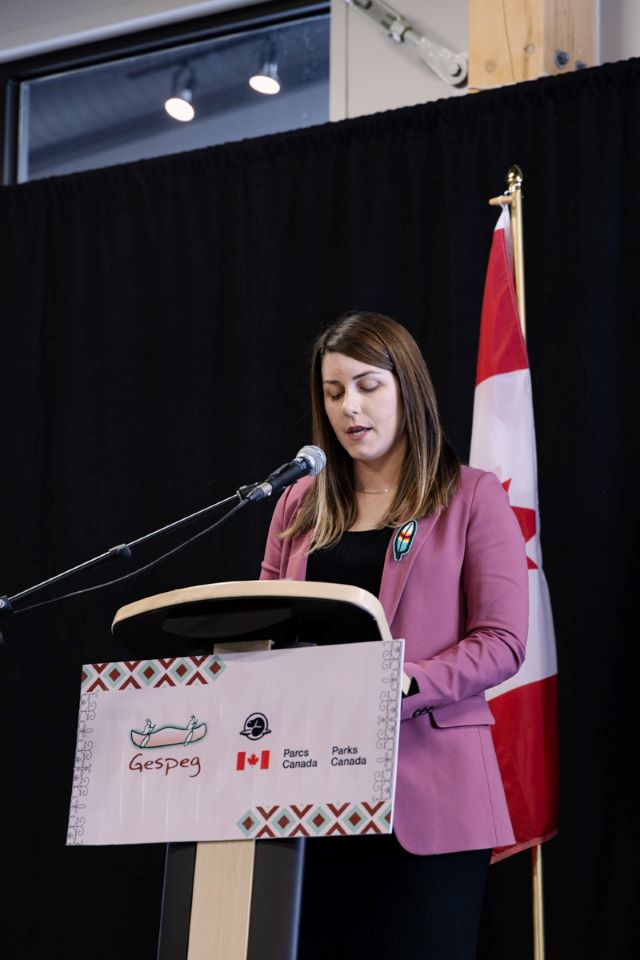
Mrs Emily Roberts, elected councillor of the Nation Micmac de Gespeg
Photo: Précision PhotoWhile this agreement is an important step, the road to reconciliation is long and must be undertaken with humility and openness. Parks Canada and the Nation Micmac de Gespeg both recognize the challenges that lie ahead and are committed to meeting them together.
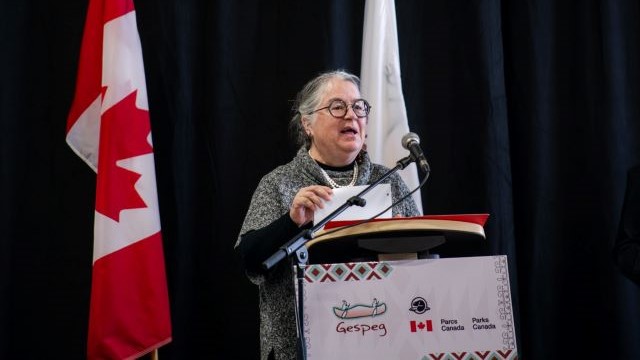
Mrs Diane Lebouthillier, Minister of Fisheries, Oceans and the Canadian Coast Guard and Member of Parliament for Gaspésie - Îles-de-la-Madeleine
Photo: Précision Photo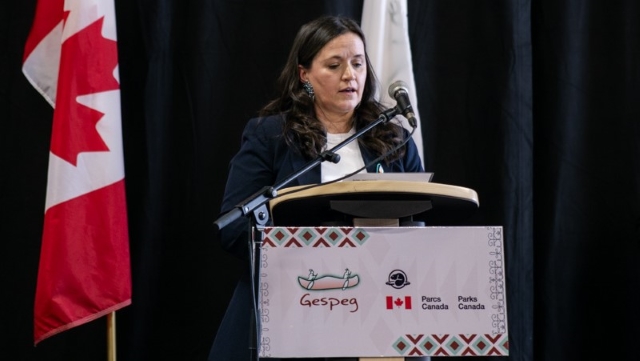
Mrs Céline Cassivi, elected councillor of the Nation Micmac de Gespeg
Photo: Précision PhotoParks Canada recognizes and honours the past and present contributions of Indigenous peoples, their cultures and their special relationship with traditional lands and waters.
Our ties with this land run deep, rooted in millennia of history, culture and tradition. For generations, our ancestors roamed this same land, sheltering and drawing sustenance from its generosity. Today, we honour their legacy, paying homage to those who came before us and paving the way for those who will follow.
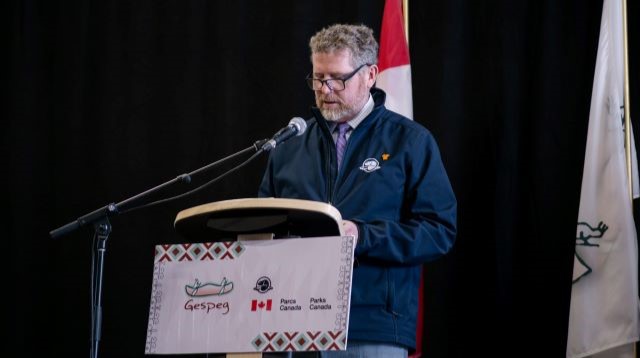
Mr Andrew Campbell, Senior Vice President Operations, Parks Canada
Photo: Précision PhotoParks Canada will work closely with Indigenous peoples to honour their ties to the land and ensure that their rights are respected.
Exchanging gifts, a part of Indigenous diplomatic tradition
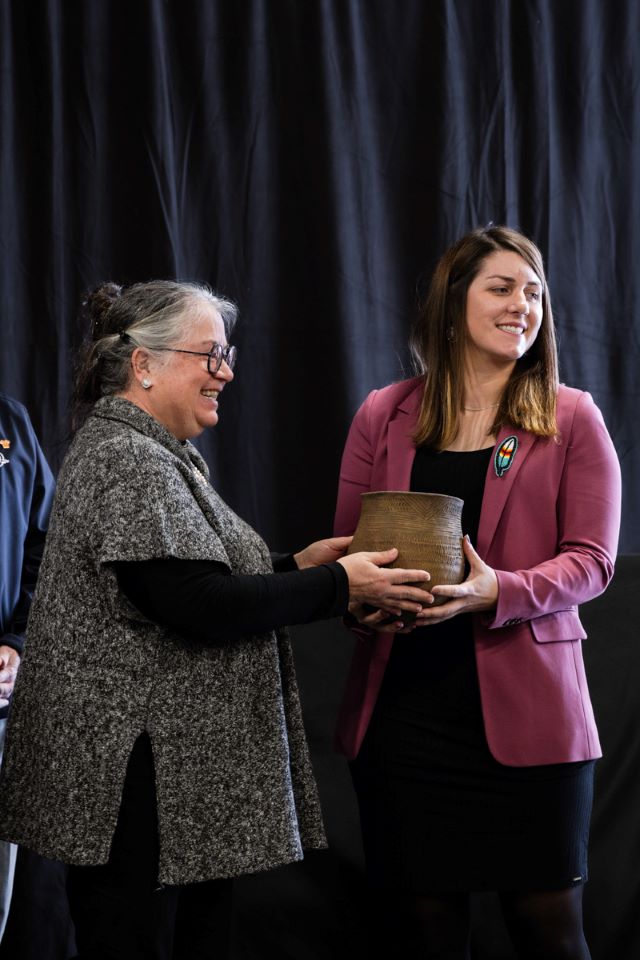
Mrs Emily Roberts receives a terracotta vase from Mrs Diane Lebouthillier. The vase was made by craftsman Michel Cadieux. It is a reproduction based on shards discovered on the Penouille peninsula in the 1960s.
Photo: Précision Photo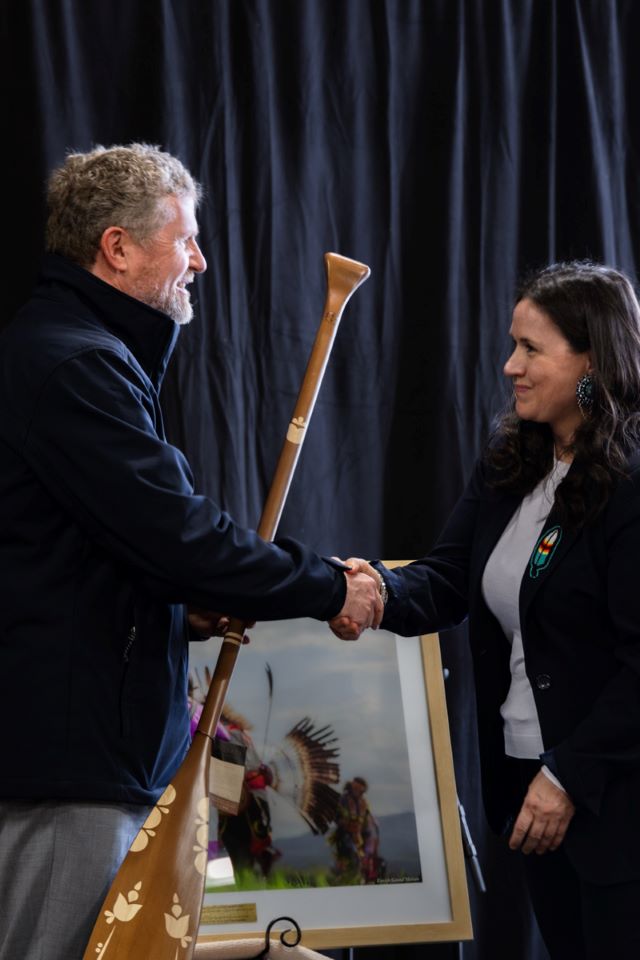
Mrs Céline Cassivi presents Mr Andrew Campbell with a paddle. The paddle, decorated in the rich First Nations tradition of incorporating flowers and plants into everyday objects, bears witness to their deep appreciation for the natural world and the bounty of Mother Earth. The paddle represents the two organisations that are now navigating side by side, in collaboration, to ensure the integrity of the territory.
Photo: Précision Photo
Related links
- Date modified :